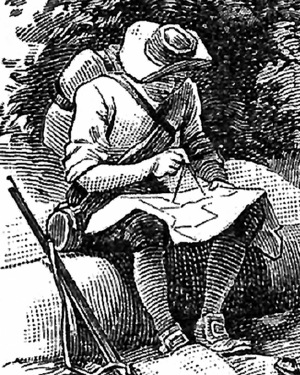Charles Mason facts for kids
Quick facts for kids
Charles Mason
|
|
|---|---|

Illustration of Mason surveying the Mason–Dixon line in 1910
|
|
| Born | April 1728 (baptised 1 May) Oakridge Lynch, Gloucestershire, England
|
| Died | 25 October 1786 (aged 58) Philadelphia, Pennsylvania, U.S.
|
| Nationality | Kingdom of Great Britain |
| Known for | Mason–Dixon line |
| Scientific career | |
| Fields | Astronomy, surveying |
| Signature | |
Charles Mason (born April 1728 – died October 25, 1786) was an English astronomer. He made important discoveries in the 1700s. He is best known for working with Jeremiah Dixon to map the Mason–Dixon line. This line became a famous border in America. It separated Maryland and Pennsylvania from 1764 to 1768. Part of this line also marks the border between Delaware and Maryland.
Contents
Early Life and Work
Charles Mason started his career at the Royal Greenwich Observatory. This observatory is near London, England. From 1756 to 1760, he worked as an assistant astronomer. He helped James Bradley, who was the third Astronomer Royal. This was a very important science job in Britain.
While at the observatory, Mason learned about Professor Tobias Mayer's Tables of the Moon. These tables were tools to help sailors find their exact location at sea. Finding your longitude (east-west position) at sea was a big problem for many years. Mason spent much of his life trying to make these tables even better. In 1787, his hard work was recognized. He received £750 from the Board of Longitude for improving the Lunar Tables.
Observing Venus in 1761
In 1761, Mason was chosen for a special mission. He was to travel to the island of Sumatra to watch the transit of Venus. A transit of Venus is when the planet Venus passes directly in front of the Sun. Scientists around the world observed this event. They hoped to use the data to figure out how far Earth is from the Sun.
Mason traveled with Jeremiah Dixon. Dixon was a surveyor and also loved astronomy. On their way, their ship was attacked by a French warship. Because of this, they could not reach Sumatra in time. They had to make their observations from the Cape of Good Hope in Africa instead. After their observations, they visited St Helena island. There, they worked with another astronomer, Nevil Maskelyne.
Mapping the Mason–Dixon Line
From 1763 to 1768, Mason and Jeremiah Dixon worked on a big project. They mapped the border between the American colonies of Pennsylvania and Maryland. Earlier mapmakers had struggled with this. They didn't have enough training or good enough tools.
Mason and Dixon led a large team of helpers. They mapped three important borders:
- The southern border of Pennsylvania, separating it from Maryland and Virginia.
- The western border of what is now Delaware, separating it from Maryland.
- The southern border of Delaware.
The two men also did other science experiments for the Royal Society. For example, they measured a degree of longitude. Mason kept a detailed journal of their work. It included his astronomy notes and personal thoughts. He wrote about the American frontier and his experiences in the colonies.
Mason and Dixon could not map the entire length of Pennsylvania's southern border. In 1767, their team crossed the Monongahela River. They also crossed the Great Indian Warpath. This path was a treaty line that limited where English settlers could go. To avoid problems with Native American tribes, Mason and Dixon had to stop. They returned east after their last observations at Brown's Hill.
Later Career and Legacy
After finishing the border survey in America, Mason went back to Greenwich. He kept working on Mayer's Lunar Tables. He also helped create the Nautical Almanac. This was a book used by sailors to navigate. He worked under Nevil Maskelyne, who was then the Astronomer Royal.
On September 27, 1786, Mason wrote to Benjamin Franklin. Mason knew Franklin because he had joined the American Philosophical Society in 1767. Franklin was a founder of this group. Mason told Franklin he had returned to Philadelphia. He was with his wife, seven sons, and one daughter. Mason was very sick and in bed. He also shared an idea for an astronomy project with Franklin. We don't know why Mason returned to the United States. We also don't know what happened with his proposed project.
Charles Mason died on October 25, 1786, in Philadelphia. He was buried at Christ Church Burial Ground there.
Remembering Charles Mason
- A crater on the Moon is named Mason in his honor.
- Charles Mason is a main character in Thomas Pynchon's 1997 novel Mason & Dixon.
- The song "Sailing to Philadelphia" was inspired by Pynchon's book. It appears on Mark Knopfler's album of the same name. Mark Knopfler sings as Dixon, and James Taylor sings as Mason.
- On August 31, 2013, surveying groups placed a memorial at his grave. His grave had been unmarked before. They used a stone from the Mason–Dixon line that had been found out of place.


